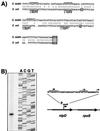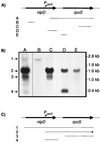Analysis of rpoS mRNA in Salmonella dublin: identification of multiple transcripts with growth-phase-dependent variation in transcript stability
- PMID: 9973354
- PMCID: PMC93505
- DOI: 10.1128/JB.181.4.1264-1268.1999
Analysis of rpoS mRNA in Salmonella dublin: identification of multiple transcripts with growth-phase-dependent variation in transcript stability
Abstract
In Salmonella dublin, rpoS encodes an alternative sigma factor of the RNA polymerase that activates a variety of stationary-phase-induced genes, including some virulence-associated genes. In this work, we studied the regulation and transcriptional organization of rpoS during growth. We found two transcripts, 2.3 and 1.6 kb in length, that represent the complete rpoS sequence. The 2.3-kb transcript is a polycistronic message that also includes the upstream nlpD gene. It is driven by a weak promoter with increasing activity when cells enter early stationary growth. The 1.6-kb message includes 566 bp upstream of the rpoS start codon. It is transcribed from a strong sigma70 RNA polymerase-dependent promoter which is independent of growth. The decay of this transcript decreases substantially in early stationary growth, resulting in a significant net increase in rpoS mRNA levels. These levels are approximately 10-fold higher than the levels of the 2.3-kb mRNA, indicating that the 1.6-kb message is mainly responsible for RpoS upregulation. In addition to the 2.3- and 1.6-kb transcripts, two smaller 1.0- and 0.4-kb RNA species are produced from the nlpD-rpoS locus. They do not allow translation of full-length RpoS; hence their significance for rpoS regulation remains unclear. We conclude that of four transcripts arising from the nlpD-rpoS locus, only one plays a significant role in rpoS expression in S. dublin. Its upregulation when cells enter stationary growth is due primarily to an increase in transcript stability.
Figures





References
-
- Amann E, Ochs B, Abel K-J. Tightly regulated tac promoter vectors useful for the expression of unfused and fused proteins in Escherichia coli. Gene. 1988;69:301–315. - PubMed
-
- Bethesda Research Laboratories. E. coli TB1 host for pUC plasmids. Focus. 1984;6:4–7.
Publication types
MeSH terms
Substances
Associated data
- Actions
LinkOut - more resources
Full Text Sources

